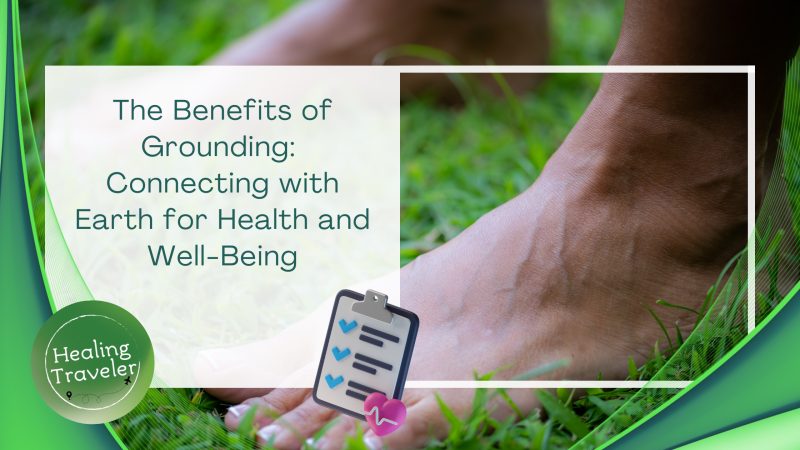
Introduction to Grounding
Grounding, also known as “earthing,” is the practice of physically connecting with the Earth’s surface by walking barefoot on natural surfaces, lying on grass, or immersing oneself in nature. This simple practice is rooted in the idea that connecting to the Earth’s electric charge can benefit both physical and mental health.
The practice of grounding is believed to have ancient roots, and modern studies suggest that direct contact with the Earth can help reduce stress, inflammation, and pain while improving sleep, mood, and overall wellness.
How Does Grounding Work?
The Earth’s surface is electrically conductive, allowing free electrons to be absorbed by our bodies upon direct contact. These electrons act as antioxidants, neutralizing free radicals, which are linked to inflammation and aging. This process also helps regulate the body’s natural electrical rhythms, which can contribute to overall health and balance.
Benefits of Grounding
-
Reduced Inflammation and Pain
- Studies indicate that grounding reduces inflammation, a root cause of many chronic conditions. The free electrons from the Earth are believed to neutralize reactive free radicals, decreasing inflammatory markers in the body.
-
Improved Sleep Quality
-
Grounding can improve sleep by regulating cortisol levels, the body’s main stress hormone. By balancing cortisol, grounding helps stabilize circadian rhythms, which promotes restful and consistent sleep patterns.
-
-
Enhanced Mood and Reduced Stress
- Being in nature has natural calming effects, and grounding further enhances this by reducing stress levels. Studies show that grounded individuals have lower cortisol levels and report greater feelings of calm, balance, and happiness.
-
Better Circulation and Heart Health
- Grounding has been shown to improve blood viscosity, which reduces the risk of cardiovascular issues. Better circulation means enhanced nutrient and oxygen delivery throughout the body, supporting heart health.
-
Faster Recovery from Injury or Physical Activity
- Athletes and active individuals often use grounding to accelerate recovery, as it can reduce delayed onset muscle soreness (DOMS) and enhance energy levels after intense exercise.
Simple Grounding Techniques
Grounding doesn’t require special equipment or extensive knowledge; it’s about connecting with the Earth. Here are simple ways to incorporate grounding into daily life:
1. Walk Barefoot Outdoors
- Walking barefoot on grass, sand, or soil is one of the easiest ways to ground. Try to spend at least 10-15 minutes a day walking without shoes on natural surfaces.
2. Sit or Lie on the Ground
- Take a few minutes each day to sit or lie on grass or sand. Reading, meditating, or stretching outside provides physical contact with the Earth and promotes relaxation.
3. Use Grounding Equipment
- For those who can’t be outdoors, grounding products like mats, sheets, and shoes are designed to connect the body to the Earth’s electric charge, allowing grounding benefits indoors.
4. Gardening or Planting
- Working with soil provides direct contact with the Earth, making gardening a grounding activity that reduces stress and increases well-being.
Scientific Research on Grounding
Emerging research suggests grounding has tangible physiological effects. A study published in the Journal of Environmental and Public Health found that grounding improved blood flow, reduced inflammation, and even altered brainwave activity. Another study noted its benefits for reducing chronic pain, while other research points to its positive effects on stress management and sleep quality. Although more research is needed, grounding holds promise as a therapeutic approach for a range of health issues.
Common Questions About Grounding
Q: Can I ground myself on concrete or other surfaces?
A: Concrete, especially if it’s in direct contact with the Earth, can be conductive, though not as effective as natural surfaces like grass or sand. Surfaces like asphalt, vinyl, and wood do not allow grounding.
Q: How long does grounding take to show results?
A: Some people report feeling calmer or more balanced within minutes, while others notice benefits after a few days or weeks of consistent practice. For best results, aim for regular, daily grounding.
Q: Is grounding safe for everyone?
A: Grounding is safe and beneficial for most individuals, though people with certain medical devices, like pacemakers, should consult a healthcare provider.
Creating a Daily Grounding Routine
A grounding routine doesn’t have to be elaborate. Even 5-10 minutes of direct contact with the Earth can help. Consider scheduling grounding sessions around other habits, like a morning walk, outdoor exercise, or evening relaxation. With consistency, grounding becomes a natural part of your wellness routine, providing both mental and physical benefits.
Final Thoughts on Grounding
Grounding is a simple, cost-free, and effective way to enhance physical and mental health by reconnecting with the Earth. As you build grounding into your routine, you may notice improvements in sleep, mood, energy, and resilience. By making grounding a part of your daily life, you’re not only supporting your wellness but also cultivating a mindful connection to the world around you.




